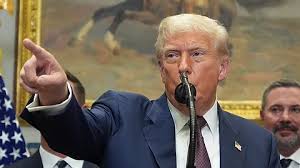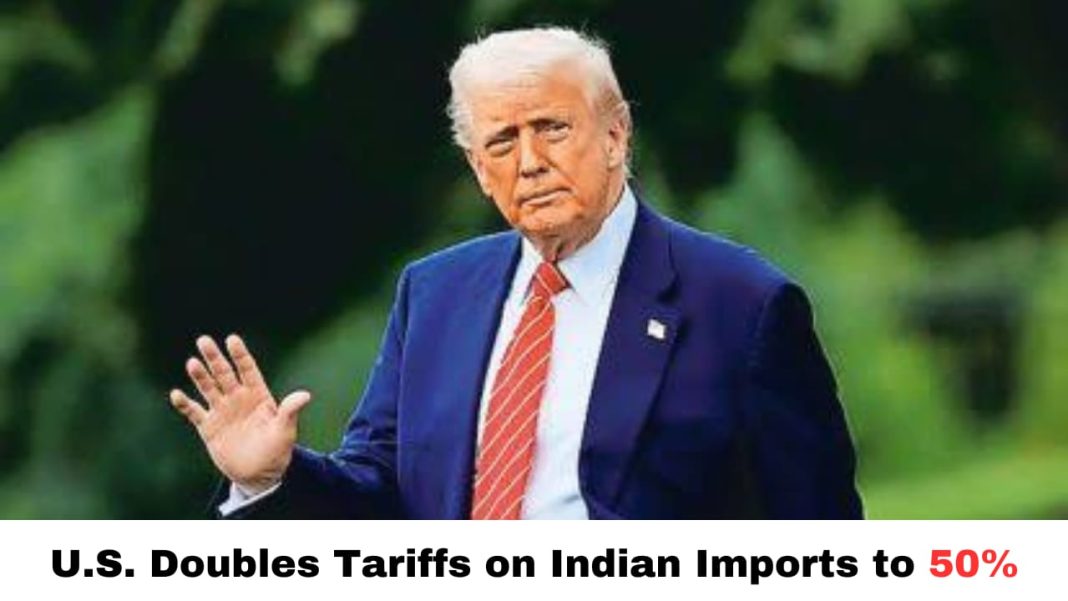Digital News Guru Business Desk:
U.S. Doubles Tariffs on Indian Imports to 50% Amid Russian Oil Row
On August 6, 2025, U.S. President Donald Trump signed an executive order imposing an additional 25% ad valorem duty on Indian imports, citing India’s continued purchases of Russian oil as a threat to U.S. national security and foreign policy interests. This doubles the existing 25% tariff to make India one of the few countries facing the highest trade levy imposed by the U.S.
Implementation Timeline
The elevated tariff structure is scheduled to take effect 21 days after August 6, giving affected exporters a narrow window for negotiation or adjustment.

Policy Rationale & Legal Backdrop
The U.S. government justified the tariff escalation under the International Emergency Economic Powers Act and other statutes, citing India’s alleged role in “indirectly importing Russian oil”—a key revenue source for Moscow’s war in Ukraine. While other countries—including China—also buy Russian oil, only India (and previously Brazil) has faced U.S. “reciprocal” penalties of this magnitude. Such selective targeting has drawn criticism from Indian commentators.
India’s Response: Unfair, Unjustified, Sovereign
New Delhi swiftly condemned the tariff move as “unfair, unjustified and unreasonable,” emphasizing India’s sovereign right to choose energy suppliers based on market conditions and energy security needs. Officials reiterated that India’s purchases from Russia—or other nations—were driven by necessity and not political alignment.
Business leaders and politics figures echoed the sentiment. Indian industrialist Harsh Goenka called for economic self-reliance, declaring that “you can tariff our exports—but not our sovereignty.” On social media, opposition voices protested India’s silence, framing it as “trade bullying” by a dominant power.
Economic Fallout: Exporters Halt, Sectors at Risk
Textile & Apparel
Export hubs in Tiruppur, Noida, and Surat began pausing U.S. orders, citing unviability under the new 50% tariff. Exporters warned of severe margin erosion, potentially rendering Indian goods uncompetitive compared to offerings from Vietnam, Bangladesh, or China.
Seafood
India’s seafood sector is staring at losses up to Rs 24,000 crore, as U.S. demand collapses under the weight of doubled tariffs.
Gems, Jewelry, Footwear & More
Over 55% of Indian exports to the U.S.—including textiles, metals, gems, jewelry, pharma, auto parts, chemicals, and footwear—are exposed to the tariff shock. Analysts suggest export volumes could decline by 40–50%, threatening the earnings of MSMEs across India.

Financial Markets & Economic Outlook
Stock Markets & Currency
Investor sentiment soured: the Nifty 50 dropped ~0.3%, and the Sensex fell ~0.36% as concerns mounted over trade volatility. The Indian rupee slid to around 87.80/USD, but likely avoided a record low through Reserve Bank of India (RBI) intervention.
GDP Growth Projections
Despite the disruption, the RBI left 2025–26 GDP growth unchanged at 6.5%, citing India’s internally driven economy. However, analysts warn that a sustained export downturn could shave growth to below 6%.
Diplomatic Fallout & Strategic Ripples
The tariffs mark a diplomatic nadir in U.S.–India relations. Trade talks collapsed after New Delhi declined Trump’s conditions—especially on agriculture and energy imports—despite earlier Indian offers to reduce tariffs and boost U.S. defense and energy imports.
Amid these tensions, Prime Minister Modi’s planned visit to China for the SCO Summit (Aug 31–Sep 1) gains added weight, suggesting India’s strategic recalibration toward regional engagement amid U.S. friction.
With U.S. envoy Steve Witkoff reportedly meeting Russian President Putin on the same day, observers view the tariff move as part of a broader U.S. plan to isolate Russia while punishing nonaligned partners.
Summary & Key Takeaways
| Category | Details |
| Tariff Rate | 50% on Indian imports |
| Trigger | India’s continuing Russian oil imports |
| Implementation | Effective 21 days after Aug 6 (from Aug 27) |
| Most Affected | Textiles, seafood, gems, pharma, auto parts |
| Export Volume Impact | Potential loss of 40–50% of U.S.-bound exports |
| Market Reaction | Nifty and Sensex declines (~0.3%) and rupee pressure |
| Political Fallout | Rising trade tensions, diplomatic strain |
| Global Strategy | U.S. using tariffs as geopolitical leverage |
What Lies Ahead?
- Will India pursue WTO arbitration or trade diversification to mitigate export disruption?
- Can diplomatic engagement forestall additional “reciprocal” tariffs or sector-specific restrictions?
- Could India reevaluate its energy partnerships, particularly Russian oil, to revive U.S. trade talks?
- How will multilateral partners—including China and EU nations—react to asymmetric U.S. targeting?
Conclusion
The U.S. decision to double tariffs on Indian imports to 50%, framed as a punitive measure over India’s ties with Moscow, marks a sharp escalation in trade diplomacy. While intended to pressure India, the move risks undermining the trade relationship and India’s export-driven SME sectors. With geopolitical fault lines deepening, India faces a complex strategic calculus: balancing energy needs, defending sovereign trade policy, and choosing alliances in an increasingly polarized global economy.
You May Also Read: Flash Flood Destroys Dharali Village Uttarakhand – 50+ Missing, 4 Dead









